It would be almost seven years later before I would have the opportunity to revisit this search.When I began my role as a Museum Technician for the GGNRA Museum Program, I was assigned the task of digitizing parts of the collection to make the Archives accessible by uploading materials to the website and creating online engagement. Personally, I also aimed to locate the Buffalo Soldiers' campsite. One day, I was just doing my job and I fell into the rabbit hole of research once more. To clarify, the "rabbit hole" of research refers to the phenomenon of veering off on a tangent, akin to the Alice in Wonderland narrative. In archival work, it can be a common occurrence when historical research leads one down a trail of footnotes associated with a collection, revealing further information.
Welcome to the Rabbit Hole
While reviewing a set of American Society of Landscape Architects (ASLA) drawings for potential duplicates, I came across their 1986 Community Assistance Team Project, completed for the U.S. Army at the Presidio. This ASLA project identified buildings 563 to 572 as historically significant and designated them as "Black Barracks, 1903". This discovery immediately reminded me of my previous research and resurrected the familiar question: could this location have been where the Buffalo Soldiers were quartered?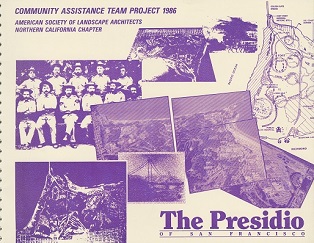 Because of the ASLA project’s designation, my new search focused on those specific buildings and their location in the East Cantonment. I queried the Erwin Thompson Research Collection (GOGA 35360), which houses extensive research notes and copies of early Presidio research materials. I figured there must be something in there and indeed the finding aid pointed to box six. I grabbed the box from the shelf, investigated the folder mentioned but found no proof as to why the ASLA report used the description "Black Barracks, 1903" at all. But what I discovered next was even more surprising.
Because of the ASLA project’s designation, my new search focused on those specific buildings and their location in the East Cantonment. I queried the Erwin Thompson Research Collection (GOGA 35360), which houses extensive research notes and copies of early Presidio research materials. I figured there must be something in there and indeed the finding aid pointed to box six. I grabbed the box from the shelf, investigated the folder mentioned but found no proof as to why the ASLA report used the description "Black Barracks, 1903" at all. But what I discovered next was even more surprising.While examining the other folders of box six I came across one labeled “Ninth Cavalry at PSF, essay, 1903.” This title instantly reminded me of my initial inquiry regarding the Buffalo Solders location at the Presidio. Seeing the title was unexpected, yet somehow fitting that this essay was nestled in the same box that referenced those barracks. I believed I had finally found an answer to the Rangers' obscure location description which had eluded me for years, so deeper down the rabbit hole I went.
Follow the Footnotes
Gregory P. Shine’s 1993 essay, entitled A Preliminary Examination of the Activities and Contributions of the Third Squadron Ninth Regiment U.S Cavalry While Posted at the Presidio of San Francisco, was completed as part of a “History of California” course. I was not surprised by the contents of Shine's essay since it narrated a familiar story; however, it created the question, "Why hadn't I encountered this document before and how much further could it take me on my search?"Shine's essay drew on numerous sources, including the Post Returns, Presidio of San Francisco, July 1900. These returns contained footnotes specifying the Ninth Cavalry as "Casuals" in 1900 meaning the Ninth was not formally attached to the post or considered part of the regular garrison. The footnote further states that they were the “only black troops stationed on the Presidio, living in an area away from the main garrison called Model Camp, which provided temporary quarters for those awaiting deployment to Manila.” Discovering the camp's name was thrilling, yet I soon learned that many before had heard the camp’s name and searched for the location, and therefore the Buffalo Soldiers, but to no avail.
Up until now, the mere knowledge that the Buffalo Soldiers had been stationed at the Presidio, but not the exact location, seemed sufficient for their story to be included in the Rangers' discussions and trainings. However, this ambiguous acknowledgment of their presence continued to trouble me. My confusion escalated because there were so many unresolved searches. Why couldn't anyone locate the Model Camp where the Ninth Cavalry had lived while the locations of many other units were easily discoverable? Why was I uneasy about not finding their camp when so many others seemed content with the vague assertion that the "Buffalo Soldiers were here, somewhere"? To start again, I revisited Thompson's collection and his interpretation of the existing evidence in the hopes I would find a new footnote to follow.
In the shadow of the Park Historian, finding the camp again.
Today, we often rely on the work of historical giants who spent years delving into archives and authoring definitive books on subjects we now study. Among the key figures contributing to the understanding of the Golden Gate National Recreation Area is Erwin Thompson. Thompson enjoyed a distinguished tenure with the National Park Service's Division of History Studies and in the late 1970s he embarked on a series of projects throughout the park. Thompson produced extensive on the histories of Alcatraz Island (entitled The Rock), Fort Mason, and the coastal fortifications of the San Francisco Bay all still often used today. The GGNRA's Park Archives and Records Center houses 31.2 linear feet of Thompson's files, known as the Erwin N. Thompson Research Collection, GOGA 35360. This collection corresponds to approximately 39 boxes of varying sizes, filled with materials he gathered from diverse sources to craft these park-related histories.
Using an accumulated list of terms from previous search attempts, I consulted Thompson’s Defender of the Gate; The Presidio of San Francisco: A History from 1846 to 1995, Chapter 10, titled War, and Insurrection, 1898-1905, to explore how he defined model camps. Thompson discussed the establishment of model camps throughout the Presidio during the Spanish-American War due to the surge of volunteer soldiers necessitating the Presidio landscape evolution from continuous military actions of that war and the ensuing “Philippine Insurrection.” He continues by evaluating the impact of early volunteer makeshift camps in 1898, linking their condition to the spread of disease. Situations like this led to the shutdown of Camp Merritt, located south of the Arguello Gate, and the unification of camps within the Presidio boundaries. Leading to the establishment of a new significantly larger, encampment named Camp Merriam. This camp encompassed an area of the Presidio that stretched from south of the Main Parade ground, through Tennessee Hollow and the East Cantonment to the Eastern boundary wall around the Lombard Gate. The new camp was designed with better sanitation areas and plumbing, the tents were built up off the ground on wooden platforms with stronger canvas material, and the quartering location of troops was based on rank.
In addition to Camp Merriam, a "Model Camp" was established to house up to 4000 of the returning soldiers. Thompson further explains that the temporary structures of the Model Camp were integrated into larger wooden housing complexes as the Presidio expanded. Could it be the wooden barracks discussed by the ASLA as being “Black Barracks in 1903” are part of Thompson’s integrated temporary structures? To add further confusion, the Archives has several photos of the area, with different names attributed to them. This raised the question: Did all of Camp Merriam become the Model Camp, or was this term designated to a particular section in or around Camp Merriam? Now that I understood Thompson’s Model Camp, but still was unsure of the exact location, I went back to the ASLA document. I just knew I had to be missing something.
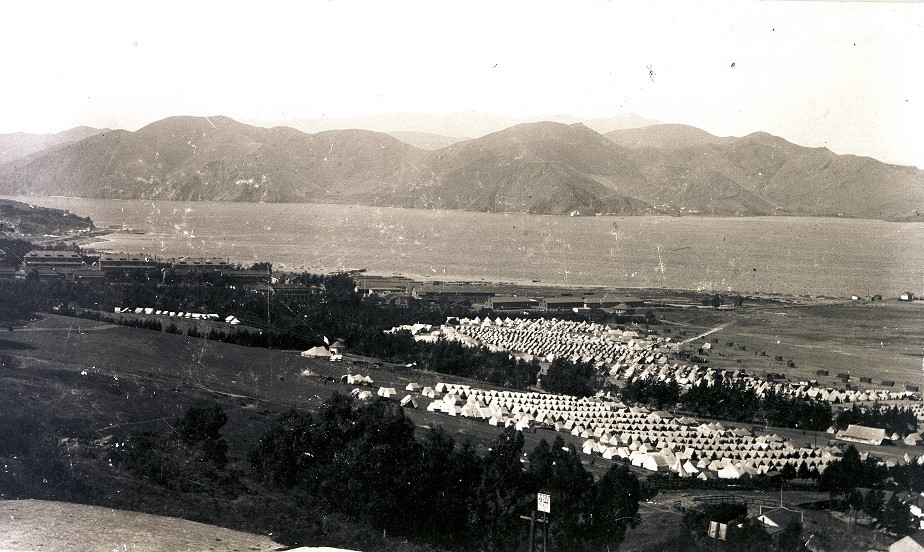
The ASLA's Community Assistance Team Project of 1986 footnotes led me to the Presidio of San Francisco National Historic Landmark District: Historic American Buildings Survey Report (HABS) from 1985. The HABS includes a single photograph with the caption "Buildings 563, 566-567, 569, 772 (I): Enlisted Barracks without Mess (1903, 1909). Single-story cavalry barracks: housed troops, many from black regiments who patrolled California's national parks before the National Park Service was established in 1916." But there was no source provided. How could that be? How could this be written with no footnote to back it?

Unable to find a documented source that confirmed the ranger’s story about the Buffalo Soldiers, I wondered if the tale came from a single sentence accompanying a photo in that publication, extrapolated over time? As I was scratching my head reality set in, I was back where I started all those years ago. Despite following the footnotes, bibliographies, and other sources that took me from the ASLA documentation, Thompson’s research, and Shine’s essay all the way to the HABS survey, I had found no direct mention of these buildings to prove that the Buffalo Soldiers had lived in them. I discovered a lot of circumstantial evidence that seemed to put the Buffalo Soldiers in or around these buildings. Here again, my search had reached an impasse, and I had other things to do. I was about to give up my pursuit, until a few months later two things happened.
First: Archival Serendipity
While reading the Post Diary from the Presidio of San Francisco, part of GOGA 39814, I can't recall precisely what I was searching for, I found detailed changes in command, troop movements, and various historical information related to the post. Immediately I thought this could be a promising document to verify historical locations of individual units like the Ninth Cavalry. However, the GGNRA archive contains only two diaries and, as it turned out, they offer less information than I initially hoped. They span the years 1931 to 1937 and 1946 to 1953, respectively. Notably, they differ in presentation, the 1931 diary does not contain a historical post timeline whereas the 1946 diary starts with one that discusses the Presidio's establishment by Colonel Juan de Anza in 1776, an 1808 earthquake that destroyed buildings in the Presidio, and the organization of the first U.S. Army companies of the 30th Infantry at "Model Camp" on March 16, 1910. From this mention in the second diary, we can confirm that the Model Camp was known and referred as that specific name until 1910. The inclusion of this detail in a timeline alongside the founding of the Presidio, and its absence from the 1931 diary, is puzzling. Despite this data, the exact location of the Model Camp remained elusive. Nevertheless, I had now learned that the 30th Infantry was once stationed at the Model Camp as well. This information reignited my search because it was evident to me, that the Model Camp was something different from Camp Merriam, but how do I prove it? It seemed like I was still missing something.
Second: It’s in the name
While digitizing some photos a few days later, I came across views of the Presidio's “North Cantonment”, I thought, “I didn’t know the Presidio had a North Cantonment.” I knew about the east and west ones, why was there a north, and where was it? I checked out a map of the Presidio and realized the west cantonment was at Fort Winfield Scott, the east was at the Presidios’ eastern border wall, and the north one was at Crissy Field. All at once, I knew, this was what I was missing. The military sometimes gave places multiple names - both geographically and descriptively - based on purpose or place. East and west cantonments are more than just past military phrases they are used in addition to area names like, Infantry Terrace, Pilots' Row, Main Post, and Crissy Field; both reflect historically accurate military base terminology. As I mulled this over, I also realized I had been looking for a place called the “Model Camp” without truly understanding its nature. It dawned on me that if I wanted to know where a Model Camp would have been built on an Army base, I had to figure out what a Model Camp was, or at least learn if Thompson’s definition was accurate. The assumptive knowledge about these camps I had gained seemed sufficient until curiosity, and possibly dumb luck, led me to search for "What is an Army Model Camp," uncovering fascinating details.
Before the U.S. maintained a large regular Army, if war was declared, Congress would request volunteers muster from each state in the nation. To train these citizen soldiers they were sent to large military bases and quartered at camps that modelled proper U.S. Army life, techniques, and policies. These camps were colloquially called “Model Camps.” Each volunteer group reported that they lived in their own camp. In a way, this information confirmed Thompson’s description of Camp Merriam as being a collection of model camps created during the Spanish-American War. But what was meant by his statement “In addition to Camp Merriam, the Presidio also built a “Model Camp?” It would seem there was always some hint that although model camps were mostly slang references to the volunteer encampments, there was at some point a concerted effort to build a separate formal Model Camp.
Archived digital togetherness
Now that the designation of Model Camp made sense, I still needed to determine its location. Recall that Thompson defined Camp Merriam as a composition of the various volunteer model camps, and it occupied a significant area of the Presidio. Conveniently, and possibly more importantly, my previous search about the nature of a model camp revealed that the National Archives and Records Administration (NARA) had digitized a Plan of Model Camp at the Presidio of San Francisco, Cal from 1899. Admittedly, I was fascinated by the title, as this drawing’s existence proved a formal “Model Camp” was planned. With a few mouse clicks, I found it. Moreover, a fully digitized version was available for use.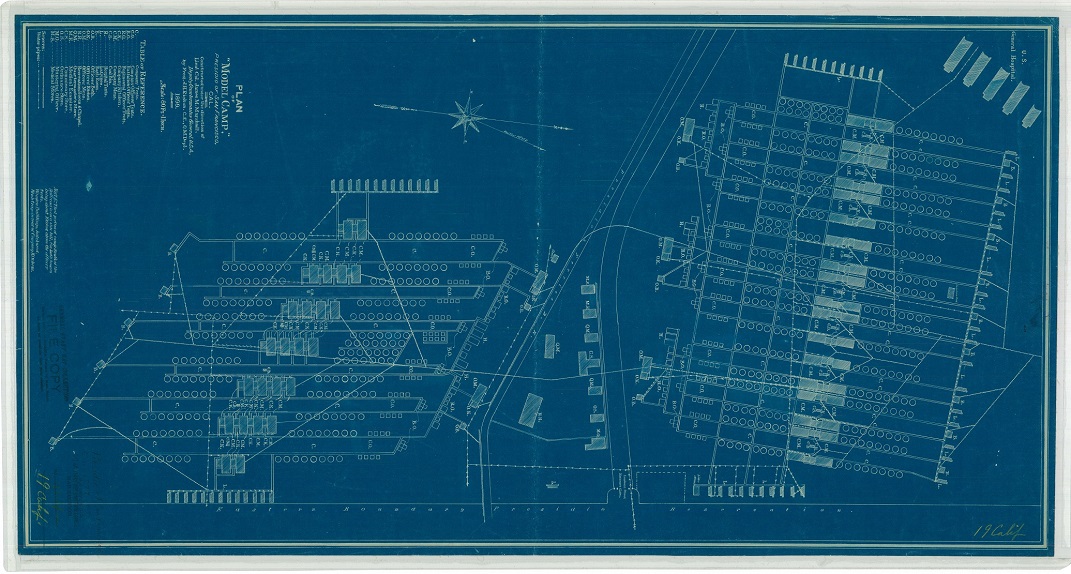
Initially I thought the term "plan" might indicate an unrealized concept and I questioned whether the Army ever implemented this design, as the GGNRA archive contains numerous Presidio schematics that were never constructed. The "Plan" illustrates the camp's intended location along the Presidio's eastern boundary wall, around Lombard Gate and the entrance of the Presidio and Ferries Railroad, near what is now Greenwich Street. While inspecting the drawing further, I realized I had seen this layout before in a photograph at the archive.
Excitedly, I sifted back through the park’s collection to locate the photograph I remembered seeing. Upon finding it, I compared the Volunteer Camp photo circa 1900 with the NARA Model Camp plan from 1899, it matched! The Army built a formal “Model Camp!” The wooden structures' location and quantity match, and the number of circular tents in the plan are the same as the photo. The angled structures of the Army hospital on the plan are also correctly placed according to the photo. The photo and corresponding plan confirm that the Model Camp was smaller than, and sat within, Camp Merriam, confined to the area near the eastern border. This site also aligns with location of the buildings mentioned in the ASLA and HABS, which means it was likely the placement of the Buffalo Soldiers, a "casual" garrison awaiting reassignment "away from the main garrison," which was how Shine described their location in his annotated bibliography of the Presidio Post Returns from July 1900.
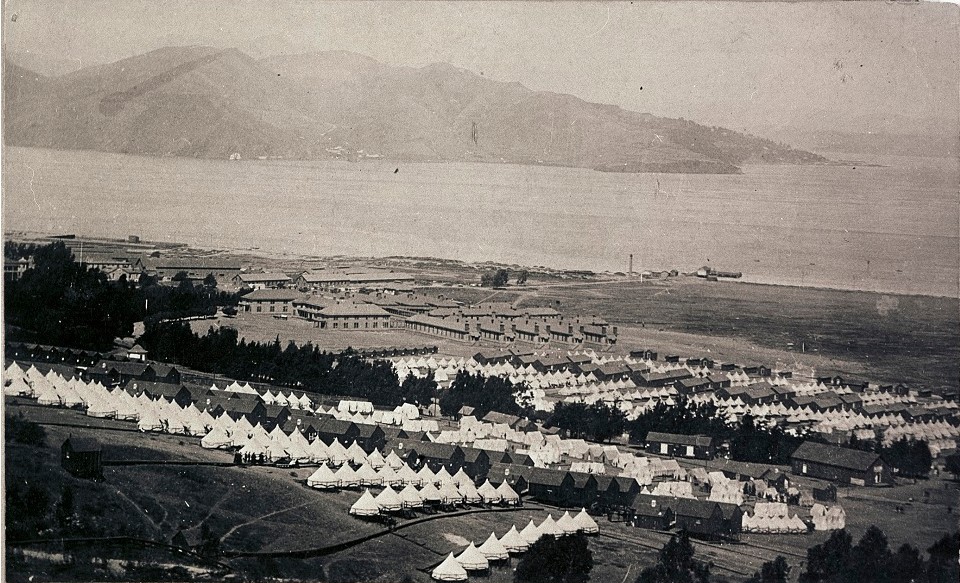
A major discrepancy, which delayed the answer but is easily explained, is that the archives photo labels the area in question as The Volunteer Camp, which as it turns out makes sense. The model camp was not only where incoming soldiers learned the official camping methods of the U.S. Army, but it was also the place where state volunteer soldiers, upon return from the Philippines, were mustered out of service, possibly explaining why one of the buildings on the NARA plan was designated as a "Mustering Office." Like other locations in the Presidio, this was one location with two names and two functions.
Extra! Extra!
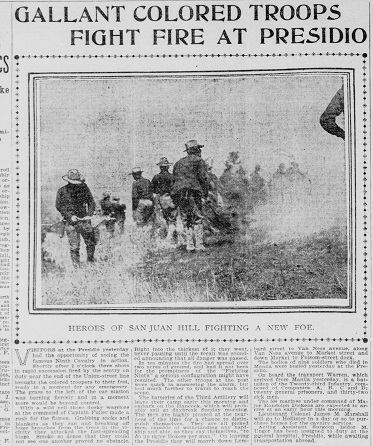
Apart from Gregory Shine's research and a footnote in the Post Returns, there was no additional military records confirming the presence of the Ninth Cavalry at the Presidio. This was frustrating because I still wanted to know where they were encamped. Seeking a new method to investigate the Buffalo Soldiers whereabouts and existence here, I considered newspapers. I hoped there was an event or social activity that could corroborate the existence of the Ninth Cavalry in San Francisco at the time. Chronicling America, by the Library of Congress, offers free access to digitized historical newspapers from across the nation. Though its collection is numerous it is still limited to what people have been able to upload. The site is updated regularly as more newspapers enter public domain or as small organizations find the means to scan their local editions. Nonetheless, it seemed a promising next step.
Using "Ninth Cavalry" as my search term, I fortuitously discovered an article in the San Francisco Call which mentioned the "Famous Ninth Cavalry" near a fire "left of the car station" in 1900. The edition dated July 28th detailed how the Ninth Cavalry's proximity to the tracks prevented "a serious conflagration." While other troops also responded, they had to travel much further to arrive at the scene.
Because of this article and after years of searching, I am confident I have located the exact site of the Model Camp where the Buffalo Soldiers were likely quartered. This camp situated near the Lombard Gate on the eastern border of the Presidio is "away from the main garrison," consistent with historical descriptions found in the Post Return. It would also be proximate to the "car station" referenced in the 1900 SF Call, and as the 1899 Model Camp Plan also verifies, the Presidio and Ferries railroad passed through the Model Camp. Apparently finding history may be by accident, quite literally. If there was no fire in 1900, we may never have been able to better confirm the Ninth Cavalry was in the Presidio near that site at that time.
Conclusion.
This research journey illustrates the significance of archival research, following footnotes, and the value of accessible historical documentation, which sometimes leads to falling into a research rabbit hole. The discovery of NARA’s digital copy of the Model Camp plan, which was unavailable during previous searches, was pivotal to the quest and highlights the importance of continued historical examination and ongoing research. Just because we already looked for something, somewhere once doesn’t mean we shouldn’t check again. Who knows what was uploaded yesterday?Although speculation remains of whether the Buffalo Soldiers occupied any of the currently existing Presidio buildings. It is crucial that we continue to support preservation, accessibility, and digitization of historical materials to allow for ongoing research that uncovers new insights and search directions. Historical exploration shines a light on the past and helps us gain a more comprehensive understanding of our shared history.
Sources outside the GGNRA Museum Program
The San Francisco call. [volume] (San Francisco [Calif.]) 1895-1913, July 28, 1900, Image 11 « Chronicling America « Library of Congress (loc.gov)
Plan of Model Camp, Presidio of San Francisco, California | DPLA
